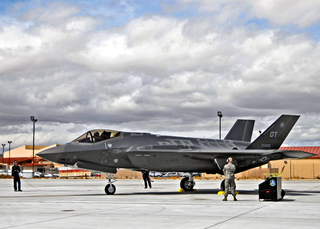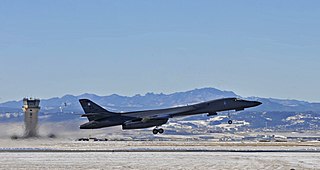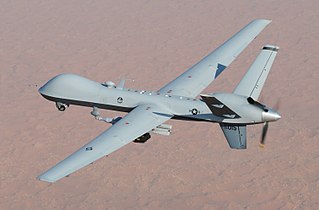
The 95th Reconnaissance Squadron is a squadron of the United States Air Force. It is assigned to the 55th Operations Group, Air Combat Command, stationed at Offutt Air Force Base, Nebraska. The squadron is equipped with several variants of the Boeing C-135 aircraft equipped for reconnaissance missions.

The 17th Training Wing is a United States Air Force unit assigned to the Air Education and Training Command Second Air Force. It is stationed at Goodfellow Air Force Base, Texas. The wing is also the host unit at Goodfellow. It was activated as a non-flying wing on 1 July 1993. Its mission is to train intelligence personnel in all the branches of the armed forces, as well as firefighters and a few other specialties. The wing trains Air Force enlisted intelligence, cryptology and linguist AFSCs 1N0, 1N1, 1N2, 1N3, 1N4, 1N5, 1A8, Air Force intelligence officer AFSC 14N, and military firefighters from all branches. Many corresponding Army, Navy, Space Force, and Marine Corps intelligence personnel are also trained at Goodfellow AFB, and assigned to the local units.

The 17th Bombardment Group is an inactive United States Air Force unit. The group was last stationed at Hurlburt Field, Florida.

The 42nd Attack Squadron is a United States Air Force unit assigned to the 25th Attack Group located at Creech Air Force Base near Indian Springs, Nevada. It flew the General Atomics MQ-9 Reaper unmanned aerial vehicle. The 42nd oversaw the training and combat deployment of aerial vehicle and sensor operators assigned to the Reaper.

The 13th Bomb Squadron is a squadron of the United States Air Force. It is assigned to the 509th Operations Group, Air Force Global Strike Command, stationed at Whiteman Air Force Base, Missouri. The squadron is equipped with the Northrop Grumman B-2 Spirit Stealth Bomber.

The 31st Test and Evaluation Squadron is a United States Air Force unit, assigned to the 53d Test and Evaluation Group, stationed at Edwards Air Force Base, California as a geographically separated unit of the 53rd Wing. The 31 TES is an Air Combat Command (ACC) tenant unit at Edwards, providing personnel to support combined test and evaluation on Air Force weapons systems.

The 20th Bomb Squadron is a unit of the 2d Operations Group of the United States Air Force located at Barksdale Air Force Base, Louisiana. The 20th is equipped with the Boeing B-52H Stratofortress.

The 28th Bomb Squadron is a squadron of the United States Air Force. It is assigned to the 7th Operations Group, Global Strike Command, stationed at Dyess Air Force Base, Texas. The squadron is equipped with the Rockwell B-1B Lancer.

The 37th Bomb Squadron is part of the 28th Bomb Wing at Ellsworth Air Force Base, South Dakota. It operates Rockwell B-1 Lancer aircraft providing strategic bombing capability.

The 93rd Bomb Squadron, sometimes written as 93d Bomb Squadron, is a squadron of the United States Air Force Reserve. It is assigned to the 307th Operations Group of Air Force Reserve Command, stationed at Barksdale Air Force Base, Louisiana. The squadron is equipped with the Boeing B-52H Stratofortress, and is the Air Force's B-52 Formal Training Unit (F.T.U.).

The 73rd Special Operations Squadron is a unit of the United States Air Force, assigned to the 1st Special Operations Wing at Hurlburt Field, Florida. The squadron operates the AC-130J Ghostrider ground-attack aircraft in support of Air Force Special Operations Command.

The 128th Airborne Command and Control Squadron is a unit of the Georgia Air National Guard 116th Air Control Wing located at Robins Air Force Base, Georgia. The 128th is equipped with the E-8C Joint STARS.

The 2nd Air Refueling Squadron, sometimes written as 2d Air Refueling Squadron, is a unit of the United States Air Force. It is part of the 305th Air Mobility Wing at McGuire Air Force Base, part of Joint Base McGuire-Dix-Lakehurst, New Jersey. The 2nd Air Refueling Squadron is the second-oldest squadron in the Air Force, having over 100 years of service to the nation. It was deployed to the Philippines after World War I, during the 1941-1942 Battle of the Philippines, it was wiped out, with the Japanese forcing some of the personnel to endure the Bataan Death March. It was re-formed as an air refueling squadron by Strategic Air Command in 1949. Today, it operates the KC-46 Pegasus aircraft, conducting aerial refueling missions.

The 55th Air Refueling Squadron is an inactive United States Air Force unit. It formerly operated both the combat crew training school and central flight instructor course for Boeing KC-135 Stratotanker at Altus Air Force Base, Oklahoma.

The 911th Air Refueling Squadron is part of the 305th Operations Group, and is stationed at Seymour Johnson Air Force Base, North Carolina. The squadron was the Air Force's very first active duty squadron under the command of a reserve wing. In October 2016, the 911th, formerly geographically separated from the 6th Air Mobility Wing at MacDill Air Force Base, Florida and operated as the active duty associate to the 916th Air Refueling Wing, became the first "I-Wing" or Integrated Wing. In July 2020, it was reassigned to the 305th Operations Group at the McGuire AFB entity of Joint Base McGuire–Dix–Lakehurst, New Jersey.

The 867th Attack Squadron is an active United States Air Force unit. It was reactivated at Creech Air Force Base, Nevada, on 10 September 2012 as a remotely piloted aircraft squadron.

The 74th Reconnaissance Squadron is an active United States Air Force unit, part of the 9th Reconnaissance Wing at Beale Air Force Base, California. The squadron was first active during World War II as the 74th Aero Squadron. In 1933 it was consolidated with the 74th Pursuit Squadron, which had been organized as a reserve training organization in 1927, activating in the Panama Canal Zone, where it served during World War II as the 74th Bombardment Squadron.

The 50th Attack Squadron is a squadron of the United States Air Force, stationed at Shaw Air Force Base, South Carolina, where it operates the General Atomics MQ-9 Reaper unmanned aerial vehicle. It is assigned to the 25th Attack Group, also at Shaw, and is a component of the 432d Wing, located at Creech Air Force Base, Nevada.

The 89th Attack Squadron is a United States Air Force unit assigned to the 432d Wing as a tenant unit at Ellsworth Air Force Base, South Dakota. It has been active as a remotely piloted aircraft (drone) squadron there since 2011.

The 744th Bombardment Squadron is an inactive United States Air Force unit. It was last assigned to the 456th Bombardment Wing at Beale Air Force Base, California, and was inactivated on 30 September 1975, when its assets were transferred to another unit.

































